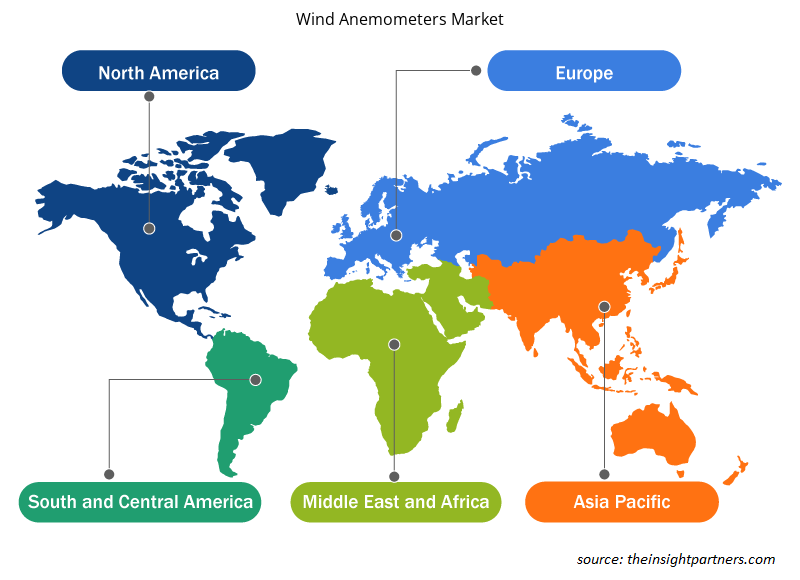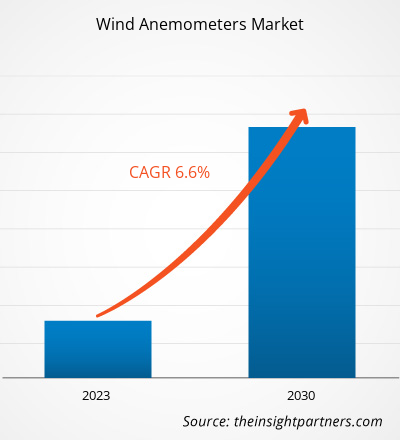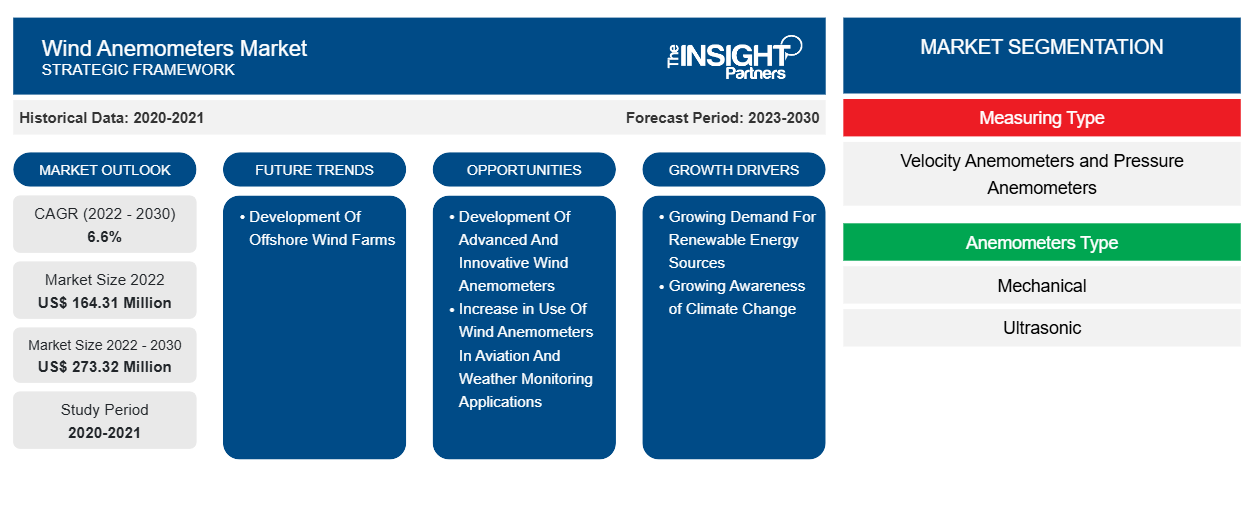[Rapporto di ricerca] La dimensione del mercato degli anemometri eolici è stata valutata a 164,31 milioni di dollari nel 2022 e si prevede che raggiungerà i 273,32 milioni di dollari entro il 2030. Si prevede che il mercato degli anemometri eolici registrerà un CAGR del 6,6% dal 2022 al 2030.
Prospettiva dell'analista:
Gli anemometri sono ampiamente utilizzati in tutte le stazioni meteorologiche, che vanno dal gelido Artico alle umide zone equatoriali. La velocità del vento aiuta a indicare un cambiamento nei modelli meteorologici, ad esempio, l'avvicinarsi di tempeste. È significativo per climatologi, ingegneri e piloti. Diverse aziende che operano nel mercato degli anemometri eolici stanno lanciando nuovi dispositivi per misurare il vento. Ad esempio, a giugno 2023, il produttore di sensori con sede nel Regno Unito Gill Instruments ha lanciato un nuovo anemometro ultrasonico a doppio asse (Windultra) per misurare la direzione e la velocità del vento. È progettato per l'uso in varie applicazioni marine o terrestri. Le caratteristiche di installazione e allineamento rapido di WindUltra includono una scelta di supporti a due poli, un supporto a palo twist-lock da 1 pollice (25-26 mm) o un supporto a palo con morsetto a fascia da 1,75-2 pollici (44-51 mm).
Panoramica del mercato degli anemometri eolici:
Un anemometro eolico misura la velocità del vento e la sua pressione. Per studiare i modelli meteorologici, questi strumenti sono strumenti essenziali per i meteorologi. Questi dispositivi sono utilizzati dai fisici durante lo studio dei movimenti dell'aria. Diverse aziende manifatturiere in tutto il mondo offrono vari strumenti anemometrici in settori quali HVAC, marina, energia eolica, edilizia e aerospaziale. Inoltre, per la velocità dell'aria o il vento, vengono utilizzati diversi tipi di anemometri per la multifunzionalità, tra cui temperatura e umidità. In base al tipo, questi possiedono anche funzionalità di registrazione o registrazione dei dati per assumere dimensioni a lungo termine in un determinato periodo. Ci sono diversi vantaggi dell'anemometro eolico, come elevata precisione e basso utilizzo di energia. Utilizzando un solo dispositivo, l'utente può misurare più parametri come velocità, velocità, direzione e pressione del vento.
Personalizza questo report in base alle tue esigenze
Riceverai la personalizzazione gratuita di qualsiasi report, comprese parti di questo report, o analisi a livello nazionale, pacchetto dati Excel, oltre a usufruire di grandi offerte e sconti per start-up e università
- Scopri le principali tendenze di mercato in questo rapporto.Questo campione GRATUITO includerà analisi di dati che spaziano dalle tendenze di mercato alle stime e alle previsioni.
Driver di mercato degli anemometri eolici:
La crescente domanda di fonti di energia rinnovabili guida la crescita del mercato degli anemometri eolici
La crescita delle fonti di energia rinnovabile , in particolare l'energia eolica, ha un impatto sostanziale sul mercato degli anemometri eolici. Secondo l'Agenzia Internazionale per l'Energia (IEA), nel 2022, l'approvvigionamento di energia rinnovabile da eolico, solare, idroelettrico, geotermico e oceanico è aumentato di quasi l'8% e la quota di queste tecnologie nell'approvvigionamento energetico globale totale è aumentata di circa lo 0,4%, raggiungendo il 5,5%. Inoltre, la quantità di elettricità generata dal vento è aumentata di 265 TWh (un aumento del 14%), la seconda crescita più grande di tutte le tecnologie di generazione di energia. L'eolico è rimasto la principale tecnologia rinnovabile, generando oltre 2100 TWh nel 2022.
I governi di vari paesi stanno prendendo iniziative per aumentare i parchi eolici, inclusa l'energia eolica. Ad esempio, a maggio 2023, ITOCHU Corporation ha annunciato che ITOCHU e Hitachi Zosen Corporation hanno iniziato i preparativi per lo sviluppo e la gestione di un parco eolico onshore in un'area di fronte all'Oceano Pacifico nel villaggio di Rokkasho, distretto di Kamikita, prefettura di Aomori e, in seguito all'incorporazione di Mutsu Ogawara Wind Power LLC, produce l'elettricità. La progettazione e la costruzione di questo progetto di parco eolico onshore dovrebbero iniziare ad aprile 2026. Allo stesso modo, a giugno 2023, è stato lanciato il più grande parco eolico galleggiante del mondo al largo della costa occidentale della Norvegia. Equinor, con 88 megawatt (MW) di capacità, genererà energia per rifornire le vicine piattaforme petrolifere e di gas. Le turbine eoliche hanno caratteristiche molto avanzate per mantenere efficienza e sicurezza. L'anemometro misura costantemente la velocità del vento e trasferisce i dati al controller della turbina eolica, che controlla il rotore a una velocità sicura. Gli anemometri eolici sono strumenti essenziali utilizzati nel settore dell'energia eolica. Quindi, le crescenti fonti di energia rinnovabile stimoleranno ulteriormente la crescita del mercato degli anemometri eolici.
Analisi segmentale del mercato degli anemometri eolici:
In base al tipo di anemometri, il mercato degli anemometri eolici è segmentato in meccanici, a ultrasuoni e altri. Il segmento meccanico ha detenuto la quota maggiore del mercato degli anemometri eolici nel 2022. Si prevede che il segmento a ultrasuoni registrerà il CAGR più elevato nel mercato degli anemometri eolici. Un anemometro meccanico contiene una ruota con un'elica o delle tazze all'estremità dei raggi della ruota. Una delle tazze contiene un magnete; ogni volta che il magnete passa un interruttore, effettua una registrazione. La registrazione dell'anemometro meccanico fornisce una lettura estremamente accurata della velocità del vento. I tipi di anemometri meccanici sono anemometri a tazza, anemometri a paletta e altri. Un anemometro a tazza è costituito da quattro tazze emisferiche fissate a un'estremità dei bracci orizzontali ad angoli uguali su un albero verticale. Il posizionamento delle tazze è tale che l'aria le attraversi in direzione orizzontale, rendendo la rotazione della tazza proporzionale alla velocità del vento. Diverse scuole in vari Paesi stanno installando gli strumenti per le stazioni meteorologiche progettate secondo gli standard stabiliti dal Dipartimento meteorologico indiano (IMD).
Analisi regionale del mercato degli anemometri eolici:
Il mercato degli anemometri eolici del Nord America è stato valutato a 59,65 milioni di $ USA nel 2022 e si prevede che raggiungerà i 102,06 milioni di $ USA entro il 2030; si prevede che registrerà un CAGR del 6,9% dal 2022 al 2030. Il mercato degli anemometri eolici del Nord America è segmentato in Stati Uniti, Canada e Messico. Gli Stati Uniti hanno detenuto la quota maggiore del mercato degli anemometri eolici in Nord America nel 2022. Le fonti di energia rinnovabili negli Stati Uniti stanno aumentando in modo significativo. Secondo i reggenti dell'Università del Michigan, l'industria eolica statunitense ha installato 13.413 megawatt (MW) di nuova capacità eolica nel 2021, portando il totale cumulativo a 135.886 MW. Questa è la seconda più alta capacità eolica installata in un anno, che rappresenta 20 miliardi di $ USA di investimenti. Il vento fornisce oltre il 9% dell'elettricità a livello nazionale, oltre il 50% in South Dakota e Iowa e oltre il 30% in Oklahoma, Kansas e North Dakota. Nel 2022, le fonti di energia rinnovabile hanno registrato circa il 13,1% del consumo di energia primaria degli Stati Uniti. Le fonti di energia rinnovabile hanno rappresentato circa il 21,5% della produzione totale di elettricità su scala di pubblica utilità. Gli anemometri eolici sono ampiamente utilizzati per misurare la velocità del vento e trasmettere i dati sulla velocità del vento al controller. Quindi, con la crescita delle fonti di energia rinnovabile, la domanda di anemometri eolici sta aumentando in modo significativo nel paese.
Analisi dei principali attori del mercato degli anemometri eolici:
Tra i principali attori del mercato degli anemometri eolici figurano LSI LASTEM Srl, Campbell Scientific Inc, Vaisala Oyj, RM Young Co, OTT HydroMet Fellbach GmbH, Gill Instruments Ltd, Adolf Thies GmbH & Co KG, Theta Instruments Co Ltd, Lambrecht meteo GmbH, Bristol Industrial & Research Associates Ltd e METEK Meteorologische Messtechnik GmbH.
Approfondimenti regionali sul mercato degli anemometri eolici
Le tendenze regionali e i fattori che influenzano il mercato degli anemometri eolici durante il periodo di previsione sono stati ampiamente spiegati dagli analisti di Insight Partners. Questa sezione discute anche i segmenti e la geografia del mercato degli anemometri eolici in Nord America, Europa, Asia Pacifico, Medio Oriente e Africa e Sud e Centro America.

- Ottieni i dati specifici regionali per il mercato degli anemometri del vento
Ambito del rapporto di mercato degli anemometri del vento
| Attributo del report | Dettagli |
|---|---|
| Dimensioni del mercato nel 2022 | 164,31 milioni di dollari USA |
| Dimensioni del mercato entro il 2030 | 273,32 milioni di dollari USA |
| CAGR globale (2022-2030) | 6,6% |
| Dati storici | 2020-2021 |
| Periodo di previsione | 2023-2030 |
| Segmenti coperti | Per tipo di misurazione
|
| Regioni e Paesi coperti | America del Nord
|
| Leader di mercato e profili aziendali chiave |
|
Densità degli attori del mercato degli anemometri eolici: comprendere il suo impatto sulle dinamiche aziendali
Il mercato degli anemometri eolici sta crescendo rapidamente, spinto dalla crescente domanda degli utenti finali dovuta a fattori quali l'evoluzione delle preferenze dei consumatori, i progressi tecnologici e una maggiore consapevolezza dei vantaggi del prodotto. Con l'aumento della domanda, le aziende stanno ampliando le loro offerte, innovando per soddisfare le esigenze dei consumatori e capitalizzando sulle tendenze emergenti, il che alimenta ulteriormente la crescita del mercato.
La densità degli operatori di mercato si riferisce alla distribuzione di aziende o società che operano in un particolare mercato o settore. Indica quanti concorrenti (operatori di mercato) sono presenti in un dato spazio di mercato in relazione alle sue dimensioni o al valore di mercato totale.
Le principali aziende che operano nel mercato degli anemometri eolici sono:
- LSI LASTEM Srl
- Vaisala Oyj
- RM Giovane Co.
- Strumenti Gill Ltd
- Adolf Thies GmbH & Co KG
Disclaimer : le aziende elencate sopra non sono classificate secondo un ordine particolare.

- Ottieni una panoramica dei principali attori del mercato degli anemometri eolici
Sviluppi recenti:
Le strategie inorganiche e organiche come fusioni e acquisizioni sono ampiamente adottate dalle aziende nel mercato degli anemometri eolici. Di seguito sono elencati alcuni recenti sviluppi chiave del mercato degli anemometri eolici:
- Nel 2023, Gill Instruments Ltd ha introdotto WindUltra, un anemometro a 2 assi. Il prodotto offre elevate prestazioni combinate con robustezza, design compatto e rapidità di installazione e allineamento, pur continuando a fornire il rilevamento ultrasonico ad alta precisione della velocità e della direzione del vento per cui Gill è rinomato.
- Nel 2022, METEK ha acquisito i settori commerciali di Theodor Friedrichs GmbH & Co. I prodotti di Theodor Friedrichs GmbH & Co. includono la tecnologia dei sensori convenzionali, il data logger di tipo Combilog ampiamente utilizzato e una varietà di camere di prova.
- Analisi storica (2 anni), anno base, previsione (7 anni) con CAGR
- Analisi PEST e SWOT
- Valore/volume delle dimensioni del mercato - Globale, Regionale, Nazionale
- Industria e panorama competitivo
- Set di dati Excel
Report recenti
Rapporti correlati
Testimonianze
Motivo dell'acquisto
- Processo decisionale informato
- Comprensione delle dinamiche di mercato
- Analisi competitiva
- Analisi dei clienti
- Previsioni di mercato
- Mitigazione del rischio
- Pianificazione strategica
- Giustificazione degli investimenti
- Identificazione dei mercati emergenti
- Miglioramento delle strategie di marketing
- Aumento dell'efficienza operativa
- Allineamento alle tendenze normative





















 Ottieni un campione gratuito per - Mercato degli anemometri eolici
Ottieni un campione gratuito per - Mercato degli anemometri eolici